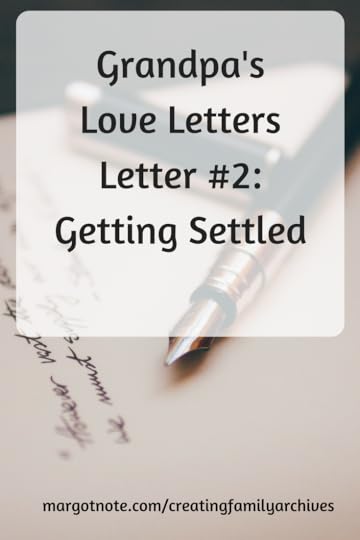Margot Note's Blog, page 44
January 31, 2018
Letter 7: Your Ever Faithful Sweetheart
I'm continuing my series of scanning, transcribing, and annotating my grandfather's love letters to my grandmother leading up to their marriage in June 1940. The letters are chronologically organized and preserved, using the methods I discuss in detail in my book, Creating Family Archives: How to Preserve Your Papers and Photographs.
The seventh letter in this series raises many questions. Why is Otto's paycheck so secretive? Why is it coming from New York? Who was Charles (Grandpa's brother) visiting on Butter Street? What are the other things Grandpa will do once he gets home? Most importantly, will Ray and Otto come home for the weekend or not?!
I can't imagine what it would be like to work in one place and have your family in another, even if it's about two hours away like Scranton, Pennsylvania and Paterson, New Jersey is. It must get tiresome to come home every weekend, when you just want to relax from a week of work.
Here's a picture I found of my grandfather, my grandmother's step-brother, and an unknown friend. The friend doesn't look familiar, but I have to look more in my photo archives to see if there are other pictures of him. To me, he looks very Lithuanian so I wonder if it's a relative from my grandmother's side of the family. It's definitely not Otto, who is pictured in this post. Who is this man?
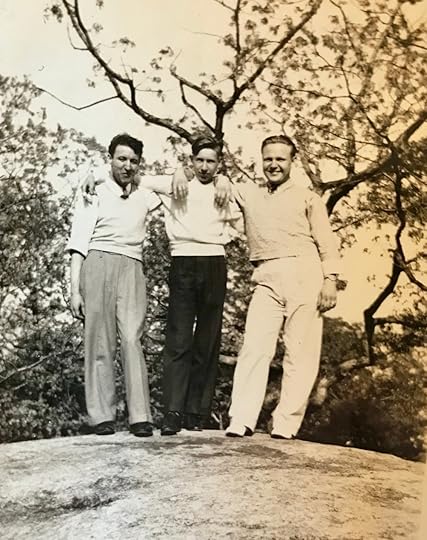
Ray, Joe, and unknown friend from (I'm assuming) the late 1930s

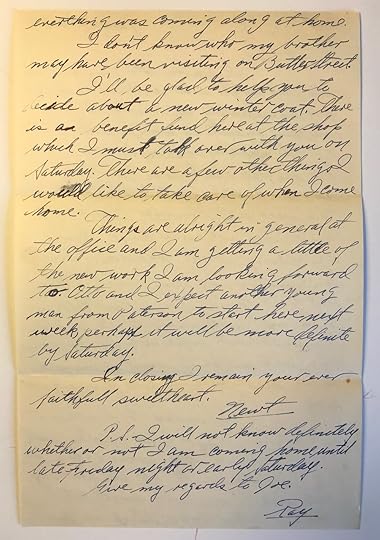
***
January 31, 1940
Dearest One:
I received both your and Joe's letter last night but did not answer them immediately as [I] wanted to have something definite to write about Saturday. If the weather is alright and Otto gets his pay check from New York in time, we will definitely come home this week-end. However there is a chance that we may come home regardless of what happens. Please don't mention anything about Otto's pay check coming from New York as it is not supposed to be public. I sincerely do hope we do go home this week-end as I want so much to be near you and hold you in my arms.
I'm sorry to hear your mother and Joe are not feeling well. I hope they get well soon again. It was nice of you to tell me how my folks are. I received a small letter from my father today telling me how everything was coming along at home.
I don't know who my brother may have been visiting on Butter Street.
I'll be glad to help you to decide about a new winter coat. There is a benefit fund here at the shop which I must talk over with you on Saturday. There are a few other things I would like to take care of when I come home.
Things are alright in general at the office and I am getting a little of the new work I am looking forward to. Otto and I expect another young man from Paterson to start here next week, perhaps it will be more definite by Saturday.
In closing I remain your ever faithful sweetheart.
Newt
P.S. I will not know definitely whether or not I am coming home until late Friday night or early Saturday.
Give my regards to Joe.
Ray
.***
To learn the preservation secrets used by libraries, archives, and museums to protect their priceless materials (that you can also use for your family heritage items) read my book:
Creating Family Archives: How to Preserve Your Papers and Photographs
By Margot Note
If you like archives, memory, and legacy as much as I do, you might consider signing up for my email list. Every few weeks I send out a newsletter with new articles and exclusive content for readers. It’s basically my way of keeping in touch with you and letting you know what’s going on. Your information is protected and I never spam.
Ready to get started creating your family archives? Here are some of my favorite products:
Follow me on Pinterest | Instagram | Twitter | LinkedIn | Facebook
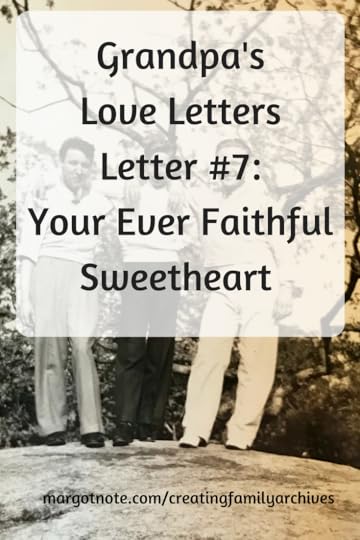
January 27, 2018
Book Review Bonanza
In the course of my professional life, I've read many books about archives, libraries, and information management issues to keep abreast of the field. I thought I'd share some of my favorite books and reviews with you. Just click on the book title that interests you, and you'll be able to download my review.
Interested in reading more? Check out my books:
Managing Image Collections: A Practical Guide (Chandos Information Professional Series)
By Margot Note
Project Management for Information Professionals
By Margot Note
Creating Family Archives: How to Preserve Your Papers and Photographs
By Margot Note
Review of Archives: Principles and Practices by Laura A. Millar (New York: Neal-Schuman, 2010).
Review of Digital Dialogues and Community 2.0: After Avatars, Trolls and Puppets. Edited by Tara Brabazon. Chandos Publishing Social Media Series. (Oxford, UK: Chandos, 2012).
Review of Disaster Management in Archives, Libraries and Museums by Graham Matthews, Yvonne Smith and Gemma Knowles. (London: Ashgate, 2009).
Review of Information 2.0: New Models of Information Production, Distribution and Consumption by Martin de Saulles. (London: Facet, 2012).
Review of Navigating Legal Issues in Archives by Menzi L. Behrnd -Klodt (Chicago: Society of American Archivists, 2008).
Review of Project Management in Libraries, Archives and Museums: Working with Government and Other External Partners by Julie Carpenter. (Oxford: Chandos, 2011).
What's a recent book on archives or libraries that is an essential read? I'd love to hear your suggestions!
Like this post? Never miss an update when you sign up for my newsletter:
Follow me on Pinterest | Instagram | Twitter | LinkedIn | Facebook
Shop the books mentioned in my reviews:
January 25, 2018
Letter #6: We Belong to Each Other
I'm continuing my series of scanning, transcribing, and annotating my grandfather's love letters to my grandmother leading up to their marriage in June 1940. The letters are chronologically organized and preserved, using the methods I discuss in detail in my book, Creating Family Archives: How to Preserve Your Papers and Photographs.
In the sixth letter of this series, Grandpa returns to Scranton after his first trip back home. He knows that he's not returning the next weekend, which makes him homesick. He's asking about other family members, especially about his sister.
During the week, he had dinner with Otto at his foreman's house. Grandpa was an avid fisherman, but I doubt that he'd brave the conditions like his foreman did. My brother and I used to go fishing with him, but all we caught were crayfish.
I found this picture of Ray and Ann together at what looks to be a park. My grandfather looks like my brother so much in this picture!

An undated picture of my grandparents from the late 1930s, I believe.
Whereas as some of Grandpa's previous letters seem saccharine, I think this letter speaks the most from the heart. He requests, "You take good care of yourself for me while I take good care of myself for we belong to each other." I like his closing too: "I love you - I love you - I love you."
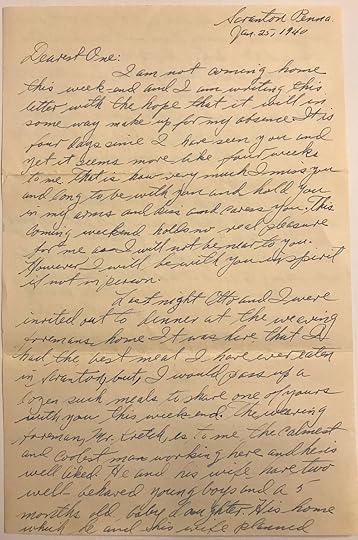

Scranton Penna.
Jan. 25, 1940
Dearest One:
I am not coming home this week-end and I am writing this letter with the hope that it will in some way make up for my absence. It is four days since I have seen you and yet it seems more like four weeks to me. That is how very much I miss you and long to be with you and hold you in my arms and kiss and caress you. This coming week-end holds no real pleasure for me as I will not be near to you. However I will be with you in spirit if not in person.
Last night Otto and I were invited out to dinner at the weaving foremans home. It was here that I had the best meal I have ever eaten in Scranton, but, I would pass up a dozen such meals to share one of yours with you this week-end. The weaving foreman, Mr. Kretch, is to me the calmest and coolest man working here and he is well liked. He and his wife have two well-behaved young boys and a 5 months old baby daughter. His home which he and his wife planned and on which he did alot [sic] of work himself is very nice. When our conversation changed to fishing he told us of his experiences white fishing and invited Otto and I to go with him some time. To give you an idea of what kind of fisherman he is, he went fishing last Saturday while the weather was from about 8 to 12 degrees below zero.
I hope you are feeling well and have no cold however slight it may be. You take good care of yourself for me while I take good care of myself for we belong to each other. Have you seen my sister or anyone else in the family? If you have tell me about it in your next letter. Give my regards to my mother and Joe, Joe and Ann, and the rest of the folks back home.
I must close now and though I am not with you I want you to know that - I love you - I love you - I love you.
Lovinly [sic] yours
"Newt"
.***
To learn the preservation secrets used by libraries, archives, and museums to protect their priceless materials (that you can also use for your family heritage items) read my book:
Creating Family Archives: How to Preserve Your Papers and Photographs
By Margot Note
If you like archives, memory, and legacy as much as I do, you might consider signing up for my email list. Every few weeks I send out a newsletter with new articles and exclusive content for readers. It’s basically my way of keeping in touch with you and letting you know what’s going on. Your information is protected and I never spam.
Ready to get started creating your family archives? Here are some of my favorite products:
Follow me on Pinterest | Instagram | Twitter | LinkedIn | Facebook

January 22, 2018
Interrogating Documents with 16 Questions
When I teach my Research Methods students, I often ask them to interrogate their primary sources. When you’re working with documents—whether manuscripts from the 17th century or blog posts that were published minutes ago—you need to analyze them like detectives. Nothing should be taken at face value. Often, this means that a document may need to be read several times to unravel its meaning.
When encountering a document for the first time, ask yourself the following questions:
What type of document is this? A letter? Diary? Newspaper article?Is it the original or a copy? If a copy, is it, for example, a photocopy or a translation? How might deviations from the original affect your analysis?What is the document’s date? If unclear, what would be a reasonable estimation? What events does it mention that might give clues to when it was written?Who is the author? What might the motivations of the author be? What can you infer about the author if the document is unsigned?What sort of bias or lack of knowledge might the author have?Where did the author write the document? If not clear, where might the location be?Why and under what circumstances did the author write the document?How might the circumstances have influenced the document’s content, tone, and style?What does the document say? What does it omit?Is there any reason to believe that the document is forged, in whole or in part?Was the document published? If so, when? Did the author intend for it to be published?If your document is part of an edited collection, was it edited, abridged, or translated? What other documents are presented with it?If the document is unpublished, who preserved it? An archives or a private collection? Who is the document’s intended audience?What does the document assume that the reader already knows about the subjects discussed?What additional information would help you better interpret the document?These are just some of the questions that should be asked of any document. What other questions do you suggest?
Follow me on Pinterest | Instagram | Twitter | LinkedIn |
Like this post? Never miss an update when you sign up for my newsletter:
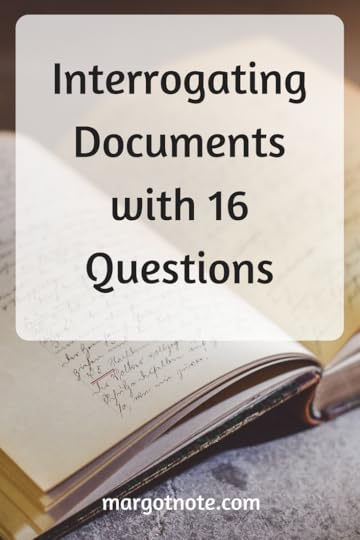
Letter #5: Morning, Noon, and Night
I'm continuing my series of scanning, transcribing, and annotating my grandfather's love letters to my grandmother leading up to their marriage in June 1940. The letters are chronologically organized and preserved, using the methods I discuss in detail in my book, Creating Family Archives: How to Preserve Your Papers and Photographs.
In this letter, Grandpa returns from his weekend trip to Paterson. He drove down with Otto (I'm assuming) on Friday night after work and returned on Sunday night. I wonder what Grandma and Grandpa did while he was in town? Did they see at show at the Fabian Theater?
I've tried to figure out who "Buttercups Curl" was, but I was unsuccessful. It sounds like a 1930s cartoon character or musician!
I believe that this is the portrait that Grandpa's referring to. It's the only formal portrait we have of my Grandma during that time.
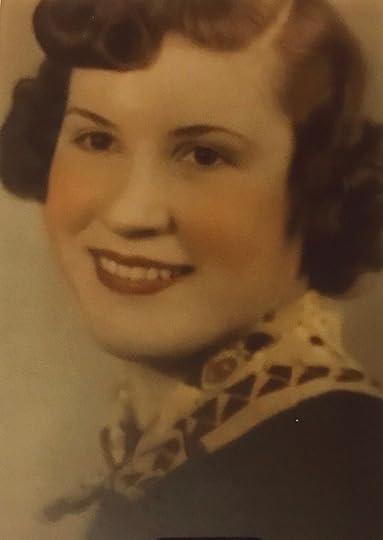
Grandma's portrait
My uncle framed it and cut a piece out of the back to reveal her note:
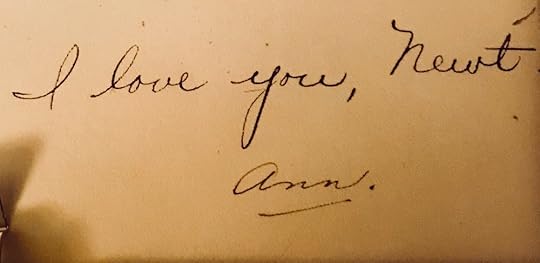
Grandma's note to Grandpa
In this letter, Grandpa mentions that Grandma would move to Scranton after they got married. I imagine that this was the plan all along, but perhaps while they were visiting, she was nervous about moving away from her friends and family to a new town. Grandma wasn't very outgoing, so I could see that a big move would be a concern.
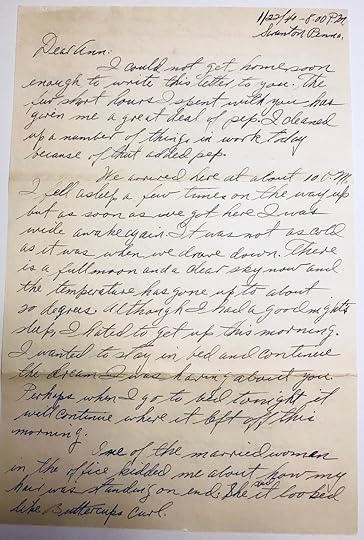
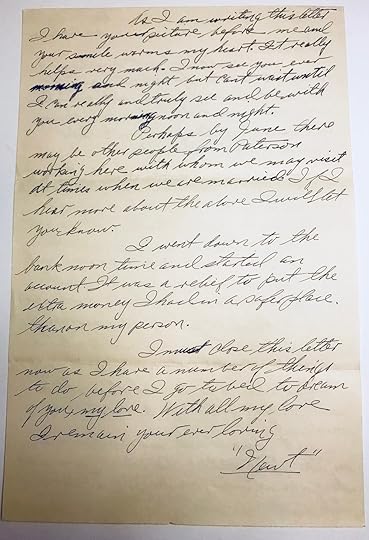
1/22/40 - 8:00 PM
Scranton Penna.
Dear Ann
I could not get home soon enough to write this letter to you. The few short hours I spent with you has given a great deal of pep. I cleaned up a number of things in work today because of that added pep.
We arrived here at about 10 P.M. I fell asleep a few times on the way up but as soon as we got here I was wide awake again. It was not as cold as it was when we drove down. There is a full moon and a clear sky now and the temperature has gone up to about 20 degrees. Although I had a good night's sleep, I hated to get up this morning. I wanted to stay in bed and continue to dream I was having about you. Perhaps when I go to bed tonight it will continue where it left off this morning.
One of the married women in the office kidded me about how my hair was standing on end. She said it looked like Buttercups Curl.
As I am writing this letter I have your picture before me and your smile warms my heart. It really helps very much. I now see you ever [sic] morning and night but can't wait until I can really and truly see and be you every morning, noon and night.
Perhaps by June there may be other people from Paterson working here with whom we may visit at times when we are married. If I hear more about the above I will let you know.
I went down to the bank noon time and started an account. It was a relief to put the extra money I had in a safe place than on my person.
I must close this letter now as I have a number of things to do before I go to bed to dream of you, my love. With all my love I remain your ever loving
"Newt"
.***
To learn the preservation secrets used by libraries, archives, and museums to protect their priceless materials (that you can also use for your family heritage items) read my book:
Creating Family Archives: How to Preserve Your Papers and Photographs
By Margot Note
If you like archives, memory, and legacy as much as I do, you might consider signing up for my email list. Every few weeks I send out a newsletter with new articles and exclusive content for readers. It’s basically my way of keeping in touch with you and letting you know what’s going on. Your information is protected and I never spam.
Ready to get started creating your family archives? Here are some of my favorite products:
Follow me on Pinterest | Instagram | Twitter | LinkedIn | Facebook
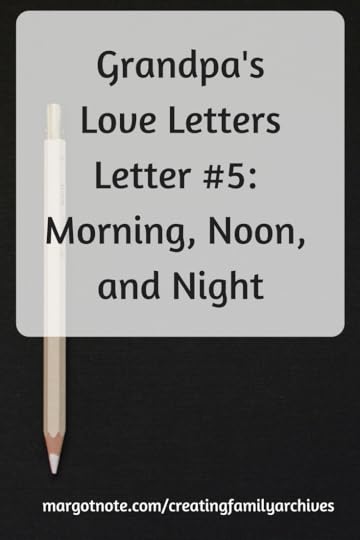
January 19, 2018
Organize Your Stuff Without Getting Overwhelmed
Everyone collects a lifetime of papers, photographs, and mementos that tell the stories of their lives. This is our "stuff."
When I talk to people about organizing their stuff, I hear repetitively, "I want to get organized, but I feel so overwhelmed!" I know the feeling of finding messes that seem so daunting that I didn't even know where to begin. But organizing your stuff doesn't have to be daunting. We just need a plan of action to make our efforts achievable.
I've created a webinar to explain the easy steps you can take to organize and preserve what's meaningful and important to you. The focus is on family and personal items--like papers, photographs, and audio-visual items--but the methods I discuss can be used for organizing anything. Feel calmer and less stressed knowing that your stuff is in order and you can find everything you need.
What this webinar offers:
Generous Q&A time so that I can answer all your questionsFollow-up materials to help you get startedExclusive access to a private Facebook group to support your effortsLearn tips and techniques right from the comfort of your computer, so grab your seat for Wednesday, February 21, 2018 from 8:00 PM – 9:00 PM EST. Won't you join me?
Register for the webinar here.
If you like archives, memory, and legacy as much as I do, you might consider signing up for my email list. Every few weeks I send out a newsletter with new articles and exclusive content for readers. It’s basically my way of keeping in touch with you and letting you know what’s going on. Your information is protected and I never spam.
To learn the preservation secrets used by libraries, archives, and museums to protect their priceless materials (that you can also use for your family heritage items), read my book:
Creating Family Archives: How to Preserve Your Papers and Photographs
By Margot Note
Ready to get started creating your family archives? Here are some of my favorite products:
Follow me on Pinterest | Instagram | Twitter | LinkedIn | Facebook
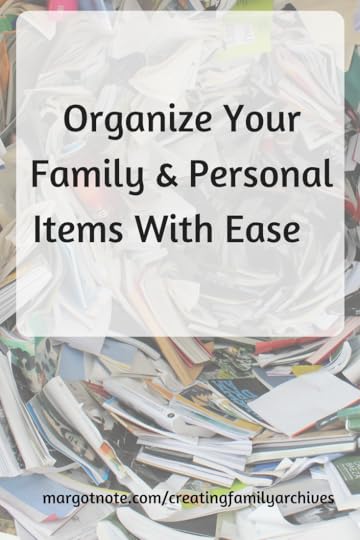
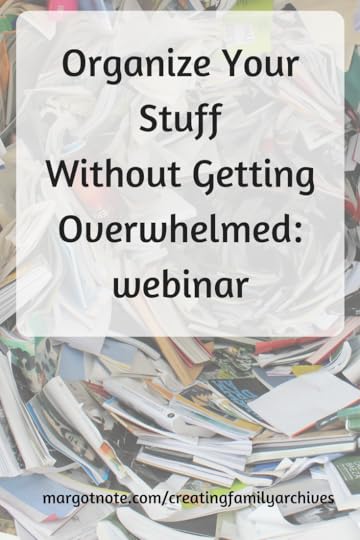

January 17, 2018
Letter #4: Man of Action
I'm continuing my series of scanning, transcribing, and annotating my grandfather's love letters to my grandmother leading up to their marriage in June 1940. The letters are chronologically organized and preserved, using the methods I discuss in detail in my book, Creating Family Archives: How to Preserve Your Papers and Photographs.
In his fourth letter, Grandpa seems to be all business. He's getting used to working in the factory and is looking forward to taking on new projects and learning new skills. He seems a bit distracted by the amount of work that's ahead of him. I think it's his way of saying that he's working very hard and earning as much money as he can. It seems odd that the check would be sent home to his father, but perhaps that was because Grandpa had just gotten settled into his boarding house.
Here's a great picture I found of him, looking very proud of himself!
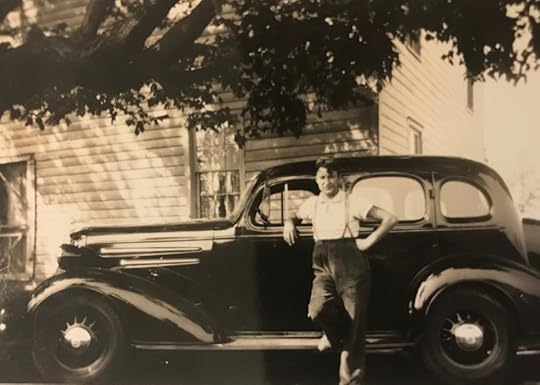
An undated picture of my Grandpa (probably in the 1930s in Paterson, NJ) with his car.
The last paragraph about my grandma seems a bit like an afterthought. A letter about work isn't very romantic, so you need to squeeze in a few nice sentiments. Grandpa's excited to return home that weekend!
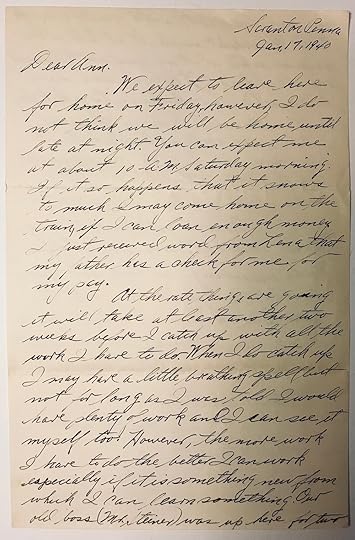

Scranton Penna
Jan. 17, 1940
Dear Ann,
We expect to leave here for home on Friday, however I do not think we will be home until late at night. You can expect me at about 10 AM Saturday morning. If it so happens that it snows to [sic] much I may come home on the train, if I can loan enough money. I just received word from Lena that my father has a check for me for my pay.
At the rate things are going it will take at least another two weeks before I catch up with all the work I have to do. When I do catch up I may have a little breathing spell but not for long as I was told I would have plenty of work and I can see it myself too. However, the more work I have to do the better I can work especially if it is something new from which I can learn something. Our old boss (Mr. Steiner) was up here for two days and left Otto with plenty of work to do. He doesn't mind it at all either because some of it is new work to him and he likes it. While he was here he dropped a few hints as to what he wants Otto and I to do in the near future with certain old stock etc. This job which will have to be supervised by either Otto or myself will take weeks if not months to do properly.
Now to get back to my first thought, my love for you. Words describing my love for you should come easy to me but I guess I am a man of action more than a man of words so you must bear with me until Saturday.
With all my love
I remain very
truly yours
Ray
.***
To learn the preservation secrets used by libraries, archives, and museums to protect their priceless materials (that you can also use for your family heritage items) read my book:
Creating Family Archives: How to Preserve Your Papers and Photographs
By Margot Note
If you like archives, memory, and legacy as much as I do, you might consider signing up for my email list. Every few weeks I send out a newsletter with new articles and exclusive content for readers. It’s basically my way of keeping in touch with you and letting you know what’s going on. Your information is protected and I never spam.
Ready to get started creating your family archives? Here are some of my favorite products:
Follow me on Pinterest | Instagram | Twitter | LinkedIn | Facebook
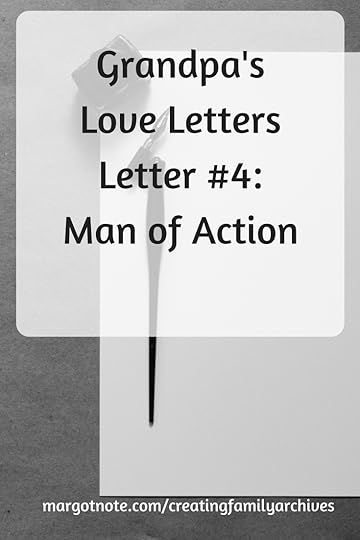
January 15, 2018
Letter #3: Sweeter Than Sweet
I'm continuing my series of scanning, transcribing, and annotating my grandfather's love letters to my grandmother leading up to their marriage in June 1940. The letters are chronologically organized and preserved, using the methods I discuss in detail in my book, Creating Family Archives: How to Preserve Your Papers and Photographs.
In Grandpa's third letter, he's feeling homesick. The weather is bad, he's breaking out, his money may run out, and the theater in town doesn't compare to the one at home.
I'm intrigued by his line, "I pray that nothing interfere with our plans," which makes me wonder what the interference could have potentially have been. As I was organizing Grandma's photos recently, I noticed that Grandpa makes his first appearance in a photo from 1935. My grandparents (one assumes) were engaged by 1939 or 1940. So wonder if family could've been a problem, especially their difficult fathers.
Here's an undated photograph of my grandmother from perhaps the late 1930s. Who took this photo?
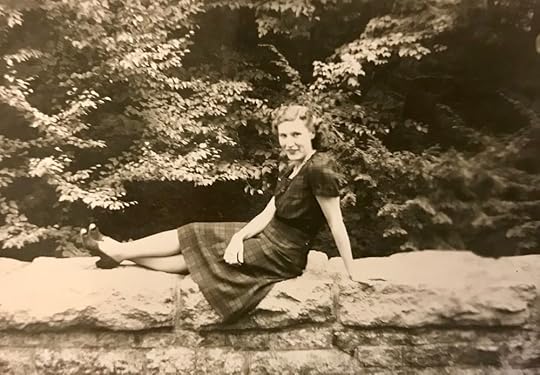
Balalaika, the movie Grandpa saw, was a 1939 American musical romance film based in Imperial Russia on the eve of World War I. The Comerfield Theater in Scranton opened in 1937 and was the jewel of the city. It featured grand staircases, murals, plush carpeting, mohair seats, and air conditioning--which was a modern innovation.
The Fabian Theater opened in 1925 in Paterson. It held over 3000 seats and was one of the biggest theaters of its time in New Jersey. It featured a two-ton chandelier, tile floors, murals, and Turkish baths (!) in the basement. So I can see why Grandpa missed his old theater!
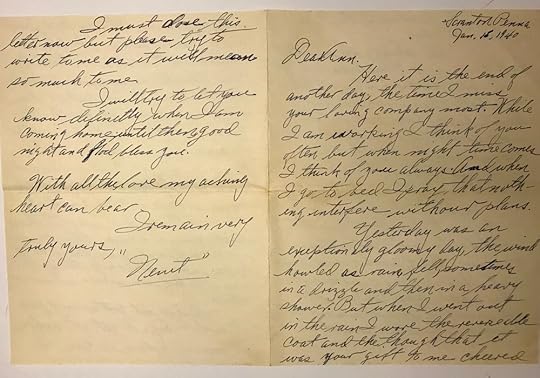
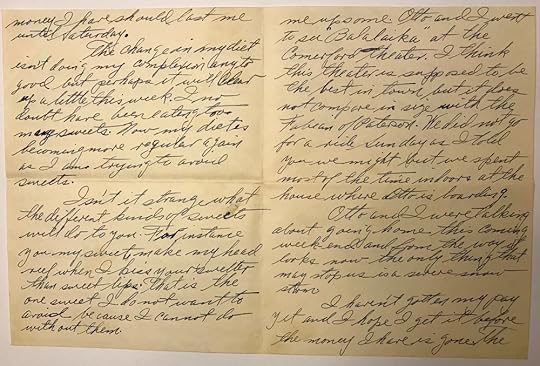
***
Scranton Penna.
Jan. 15, 1940
Dear Ann,
Here it is the end of another day, the time I miss your loving company most. While I am working I think of you often but when night time comes I think of you always. And when I go to bed I pray that nothing interfere with our plans.
Yesterday was an exceptionally gloomy day, the wind howled as rain fell, sometimes in a drizzle and then in a heavy shower. But when I went out in the rain, I wore the reversible coat and the thought that it was your gift to me cheered me up some. Otto and I went to see "Balalaika" at the Comerford theater. I think this theater is supposed to be the best in town but it does not compare in size with the Fabian in Paterson. We did not go for a ride Sunday as I told you we might but we spent most of the time indoors at the house where Otto is boarding.
Otto and I were talking about going home this coming week-end and from the way it looks now the only thing that may stop us is a severe snow storm.
I haven't gotten my pay yet and I hope I get it before the money I have is gone. The money I have should last me until Saturday.
The change in my diet isn't doing my complexion any good but perhaps it will clear up a little this week. I no doubt have been eating too many sweets. Now my diet is becoming more regular again as I am trying to avoid sweets.
Isn't it strange what the different kinds of sweets will do to you. For instance you my sweet make my head reel when I kiss your sweeter than sweet lips. That is the one sweet I do not want to avoid because I cannot do without them.
I must close this letter now but please try to write to me as it will mean so much to me.
I will try to let you know definitely when I am coming home until then good night and God bless you.
With all the love my aching heart can bear.
I remain very
truly yours,
"Newt"
.***
To learn the preservation secrets used by libraries, archives, and museums to protect their priceless materials (that you can also use for your family heritage items) read my book:
Creating Family Archives: How to Preserve Your Papers and Photographs
By Margot Note
If you like archives, memory, and legacy as much as I do, you might consider signing up for my email list. Every few weeks I send out a newsletter with new articles and exclusive content for readers. It’s basically my way of keeping in touch with you and letting you know what’s going on. Your information is protected and I never spam.
Ready to get started creating your family archives? Here are some of my favorite products:
Follow me on Pinterest | Instagram | Twitter | LinkedIn | Facebook

How to Analyze Historic Photographs
Photographs contain a wealth of information, but you need to build your visual literacy to extract clues. The social history context that photographs provide is especially important for groups who have historically not been represented in text-based archival collections, such as women or people of color. I've gathered some of the techniques I use when conducting historical analysis of photographs. While my questions are created for people trying to research their family photos, they can also be applied to photographs that you find in archival repositories.
Where and when did you found the photograph? What's its context?What type of photograph is it? (Many old photos are cabinet cards or cartes de viste). Knowing the type of photograph you are examining may help you date it. If the photograph was stored with other heirlooms, note the other items that it was kept with. Do these items provide context? Each item may help identify the others.If possible, keep the photograph in its original container as long as you can. For example, if someone tucked the item in his or her Bible, that person is probably connected to them all. Moving the item could mean you lose its context. If preservation is an issue, make a photocopy, scan, or place the originals in an archival sleeve. If you remove the original photograph to preserve it archivally, place a copy in its original spot to remind you of what items you found together.Look for identifying features. Can you find a name, date, or other information written in the margins or on the back?If the information is handwritten, can you identify who wrote it? (For instance, I can immediately recognize my paternal grandmother's handwriting). Keep in mind that people often have similar script if they were taught penmanship. Writing usually changes with age too. Do not automatically accept what has been written is accurate. Consider who wrote it and his or her motivations. Sometimes information is a mistake; sometimes, it's misrepresentation. How accurate is the information?Try to identify the people in the photograph, keeping in mind that your first identification may not be correct. Who do you recognize?Study their faces. How old are the people being pictured? Do you recognize them from other photographs? Do they look like they are related?What are the people in the photograph wearing? Clothing can provide clues to the time period, economic status, gender, ethnicity, age, and season. For example, in the nineteenth century, American women wore the same dresses year-after-year with small changes to the sleeves, according to that year's fashion. Similarly, women often purchased new bonnets annually, so you may be able to determine the year based on the bonnet's style. In the Victorian era, young children of both genders wore dresses, yet boys had their hair parted on the side, while girls had their hair parted in the middle. As you become more familar with the trends of years gone by, you will begin to see this tiny clues more clearly. Are the people wearing any jewelry, family heirlooms, or distinctive artifacts?How are the people standing or seated in relation to one another? Are the older family members still alive? Has the youngest in the family been born yet?Note the photographer's identifying information, which may be listed on the front of the photograph or the back. This will usually tell you where a photograph was taken. Once you know the photographer's studio, you can do additional research to determine a range of dates when the photograph was taken. Sometimes you can find this information online; sometimes you may have to contact a local or state historical society to get more information about the photographer. Where is the photograph taken? Outside? In a house? In a studio with props? If the photograph depicted the inside of a home, are there other photographs that show you different parts of the room? What does the room tell you about its occupants?Is there a car pictured? The make, model, and condition of the car can give you clues. Does it look like it is owned by the subjects, or is it a prop?If the setting is outdoors, examine the architectural details and distinct buildings. Do they provide clues about the date and location of the photograph?Can you tell what season the picture was taken? Are there any calendars, photographs, or textual clues inside the photograph? You may need a magnifying glass to see these details. Why was this photograph taken? Was it to commemorate a family event, such as a marriage, engagement, anniversary, birthday, graduation, christening, death, or funeral?What strategies do you use when examining photographs?
Follow me on Pinterest | Instagram | Twitter | LinkedIn |
Like this post? Never miss an update when you sign up for my newsletter:

January 12, 2018
Letter #2: Getting Settled
I'm continuing my series of scanning, transcribing, and annotating my grandfather's love letters to my grandmother leading up to their marriage in June 1940.
In this letter, Grandpa is getting settled in Scranton during his first week there. When he's not working at the factory, he's eating out, playing pool, shopping, and going to the movies. He also attends church, which he made sure to include in his letter because my grandma would've approved. Nice play, Grandpa!
One of the challenges I'm facing is determining when Grandma and Grandpa met, when they started dating, and when they became engaged. One of the advantages of setting up family archives (which I discuss in detail in my book, Creating Family Archives: How to Preserve Your Papers and Photographs) is that you can easily conduct family research. I'm using my photo archives to enrich and inform my paper archives, and vice versa.
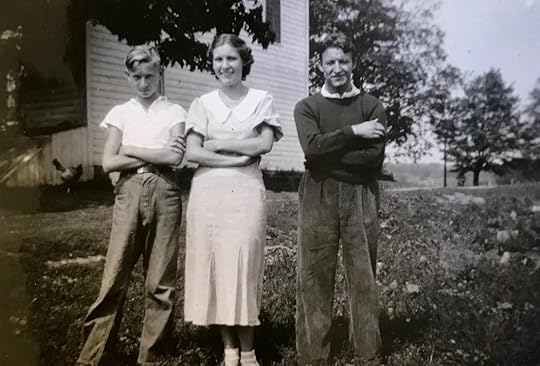
Joseph Zabit (Grandma's step-brother), Ann, and Ray in September 7, 1936
In my photo archives, I have this picture which shows my grandparents together four years before these letters were written. Were they dating already in 1936? That seems an awfully long time before they became engaged which I'm assuming was in 1939 or 1940.
I find the body language in this picture intriguing. Who was taking the picture? I wonder if it was my grandmother's stepfather--who was, from all accounts, a very abusive man. Everyone stands with their arms crossed. There's a noticeable gap between my grandparents with their arms crossed away from each other. It seems to me as if they're aware that they can't show too much affection, especially in front of parents. They both look happy though, while Joe looks like a typical sullen teenager! Some things never change.
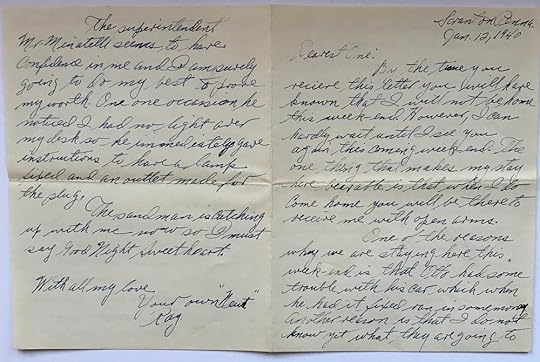
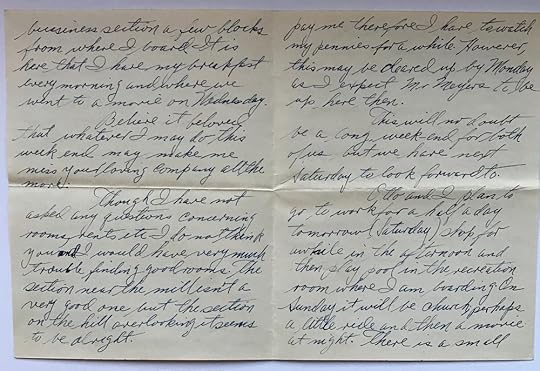
***
Scranton Penna
Jan. 12, 1940
Dearest One:
By the time you recieve [sic] this letter you will have known that I will not be home this week-end. However, I can hardly wait until I see you again this coming week-end. The one thing that makes my stay here bearable is that when I do come home you will be there to receive me with open arms.
One of the reasons why we are staying there this week-end is that Otto had some trouble with his car which when he had it fixed ran in some money. Another reason is that I do not know yet what they are going to pay me therefore I have to watch my pennies for a while. However, this may be cleared up by Monday as I expect Mr. Meyers to be up here then.
This will no doubt be a long week-end for both of us but we have next Saturday to look forward to.
Otto and I plan to go to work for a half a day tomorrow (Saturday) shop for a while in the afternoon and then play pool in the recreation room where I am boarding. On Sunday it will be church; perhaps a little ride and then a movie at night. There is a small business section a few blocks from where I board. It is here that I have my breakfast every morning and where we went to a movie on Wednesday.
Believe it beloved that whatever I may do this week end may make me miss your loving company all the more.
Though I have not asked any questions concerning rooms, rents etc. I do not think you and I would have very much trouble finding good rooms. The section near the mill isn't a very good one but the section on the hill overlooking it seems to be alright.
The superintendent Mr. Minatelli seems to have confidence in me and I am surely going to do my best to prove my worth. On one occasion he noticed I had no light over my desk so he immediately gave instructions to have a lamp fixed and an outlet made for the plug.
The sandman in catching up with me now so I must say Good Night, Sweetheart.
With all my love
Your own "Newt"
Ray
.***
To learn the preservation secrets used by libraries, archives, and museums to protect their priceless materials (that you can also use for your family heritage items) read my book:
Creating Family Archives: How to Preserve Your Papers and Photographs
By Margot Note
If you like archives, memory, and legacy as much as I do, you might consider signing up for my email list. Every few weeks I send out a newsletter with new articles and exclusive content for readers. It’s basically my way of keeping in touch with you and letting you know what’s going on. Your information is protected and I never spam.
Ready to get started creating your family archives? Here are some of my favorite products:
Follow me on Pinterest | Instagram | Twitter | LinkedIn | Facebook
